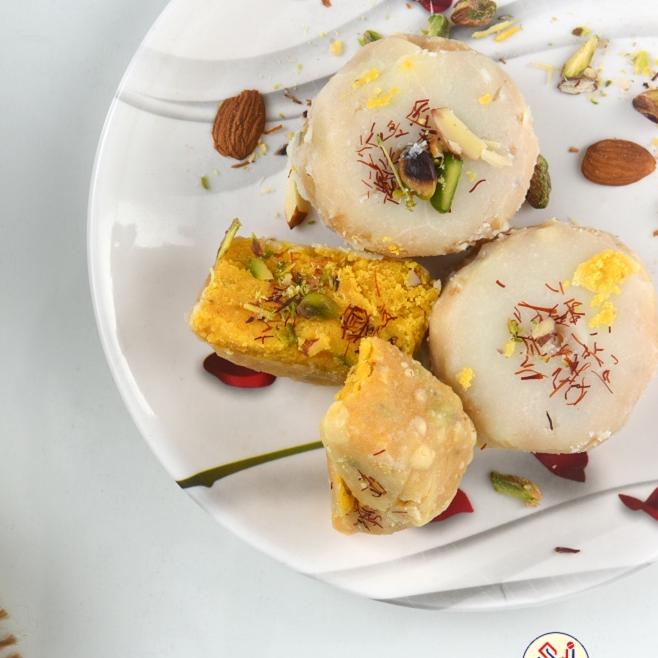Ghari Sweet traces its origins to 1857 in Surat, where it was created as an energy-rich food for soldiers. Over time, it transformed into a cultural symbol of celebration and tradition.
🍬 Types of Ghari
There are several types of Ghari, each catering to different taste preferences. The filling and flavoring make each variant unique. Here are the most popular types of Ghari you’ll find in sweet shops and traditional homes:
1. Mawa Ghari (Khoya Ghari)
The classic and most common variant, Mawa Ghari is made with thickened milk solids (mawa or khoya), sugar, cardamom, and ghee. It is rich, dense, and melts in your mouth.
2. Dry Fruit Ghari
This premium version is packed with chopped dry fruits like almonds, cashews, pistachios, raisins, and sometimes figs or dates. It is not only delicious but also offers nutritional benefits.
3. Pista Ghari (Pistachio Ghari)
In this variety, the filling consists mainly of finely ground pistachios mixed with mawa and sugar. It has a greenish tint and a distinctive nutty flavor.
4. Chocolate Ghari
A modern twist to the traditional sweet, Chocolate Ghari has become a favorite among the younger generation. Cocoa powder or melted chocolate is mixed with mawa to create this fusion dessert.
🥘 Traditional Ghari Recipe (Mawa/Dry Fruit Version)
Making Ghari at home may seem time-consuming, but it’s a rewarding process. Here’s a step-by-step traditional recipe to make Mawa Ghari with dry fruits.
📝 Ingredients:
For the Filling:
- Mawa/Khoya – 500 grams
- Powdered Sugar – 250 grams
- Cardamom powder – 1 tsp
- Almonds – 50 grams (chopped)
- Cashews – 50 grams (chopped)
- Pistachios – 25 grams (chopped)
- Nutmeg powder – ¼ tsp
- Ghee – 2 tbsp
For the Outer Layer (Dough):
- Maida (All-purpose flour) – 1 cup
- Ghee – 2 tbsp
- Water – as needed
For Frying:
- Ghee – for deep frying
For Garnishing:
- Powdered sugar (optional)
- Silver leaf (varak) – optional
👩🍳 Preparation Steps:
Step 1: Prepare the Filling
- Heat ghee in a pan and lightly roast the mawa on low flame until it turns light golden.
- Let it cool completely.
- Mix in powdered sugar, cardamom, nutmeg, and all chopped dry fruits.
- Form small round balls from the mixture and keep them aside.
Step 2: Prepare the Dough
- In a bowl, mix maida with 2 tbsp ghee.
- Gradually add water and knead into a soft dough.
- Cover and let it rest for 15–20 minutes.
Step 3: Assemble the Ghari
- Divide the dough into small balls.
- Roll each dough ball into a small puri (disc).
- Place a mawa ball in the center, fold the edges over it, and seal properly to form a round shape.
- Flatten slightly.
Step 4: Fry the Ghari
- Heat ghee in a deep frying pan on low-medium flame.
- Carefully fry the Ghari pieces until golden brown.
- Let them cool slightly.
Step 5: Garnish
- Optionally, coat the Ghari with melted ghee and dust with powdered sugar.
- You can also decorate with silver leaf (varak) for an authentic festive look.
🌟 Tips for the Perfect Ghari
- Use fresh mawa for best results. Homemade or store-bought unsweetened mawa both work.
- Fry on low to medium heat so the Ghari cooks evenly from the inside.
- Let the mawa mixture cool completely before filling.
- Store in an airtight container; it stays good for up to 4–5 days without refrigeration.
🎉 When to Serve Ghari?
Ghari is traditionally prepared during:
- Chandani Padva (post-Navratri celebration)
- Diwali
- Weddings
- Family gatherings and religious occasions
🧾 Nutritional Value
Ghari is a high-calorie dessert, rich in fats, carbohydrates, and proteins. One piece can contain around 300–500 calories, depending on the ingredients. While it’s not an everyday food, Ghari is ideal for:
- Festive treats
- Energy boosts
- Special indulgence days
🌍 Ghari in Modern Times
With changing tastes, Ghari has also evolved. Many sweet shops now offer:
- Low-sugar or sugar-free Ghari
- Flavored Ghari (Rose, Saffron, Mango)
- Mini Ghari bites
Surat remains the heart of Ghari production, with shops like Chikhliwala, Jamnadas, and 24 Carat Mithai known for their iconic offerings. During Chandani Padva, thousands of kilos of Ghari are sold in Surat alone
Frequently Asked Questions (FAQs) About Ghari Sweet
What is Ghari sweet made of?
Ghari is made from mawa (khoya), ghee, sugar, and a variety of dry fruits like almonds, pistachios, and cashews. It is wrapped in a flour dough, deep-fried in ghee, and sometimes coated with more ghee or powdered sugar.
What is the origin of Ghari sweet?
Ghari originated in Surat, Gujarat, around 1857. It was initially created to provide energy to soldiers during India’s First War of Independence. Over time, it became a beloved festive sweet.
Which festival is Ghari famous for?
Ghari is especially popular during Chandani Padva, a post-Navratri celebration observed by the people of Surat. On this day, families indulge in rich foods and sweets like Ghari.
What are the types of Ghari?
Popular types of Ghari include:
Mawa Ghari
Dry Fruit Ghari
Pista (Pistachio) Ghari
Malai Ghari
Chocolate Ghari
Modern variations even include sugar-free and flavored Ghari.
Is Ghari sweet healthy?
Ghari is high in calories, ghee, and sugar, making it more of an indulgent festive sweet than a daily snack. However, dry fruit varieties offer nutritional benefits like protein, fiber, and healthy fats.
Can I make Ghari at home?
Yes, Ghari can be made at home using simple ingredients like mawa, dry fruits, ghee, and maida. It involves making a filling, wrapping it in dough, frying it, and garnishing it with ghee or powdered sugar.
How long does Ghari last?
Homemade Ghari can last 4–5 days at room temperature if stored in an airtight container. In warmer climates, refrigeration is recommended.
Where can I buy authentic Surti Ghari?
Authentic Ghari can be purchased from popular sweet shops in Surat, such as 24 Carat Mithai, Jamnadas, or Chikhliwala. Many shops also offer online ordering and shipping across India.
What makes Surti Ghari different from other Indian sweets?
Surti Ghari is unique because of its rich filling, deep frying in ghee, and heritage linked to Surat. Its dense texture and indulgent taste set it apart from lighter sweets like Kajukatri ,rasgulla or barfi.


